
Digital Equipment Corporation (DEC)'s PDP-10, later marketed as the DECsystem-10, is a mainframe computer family manufactured beginning in 1966 and discontinued in 1983. 1970s models and beyond were marketed under the DECsystem-10 name, especially as the TOPS-10 operating system became widely used.
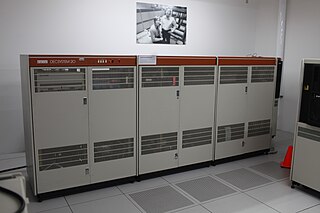
The DECSYSTEM-20 was a family of 36-bit Digital Equipment Corporation PDP-10 mainframe computers running the TOPS-20 operating system and was introduced in 1977.

The PDP-1 is the first computer in Digital Equipment Corporation's PDP series and was first produced in 1959. It is famous for being the most important computer in the creation of hacker culture at the Massachusetts Institute of Technology, Bolt, Beranek and Newman and elsewhere. The PDP-1 is the original hardware for playing history's first game on a minicomputer, Steve Russell's Spacewar!

In computing, time-sharing is the sharing of a computing resource among many tasks or users. It enables multi-tasking by a single user or enables multiple-user sessions.
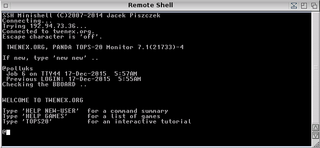
The TOPS-20 operating system by Digital Equipment Corporation (DEC) is a proprietary OS used on some of DEC's 36-bit mainframe computers. The Hardware Reference Manual was described as for "DECsystem-10/DECSYSTEM-20 Processor".

Raytheon BBN is an American research and development company based in Cambridge, Massachusetts, United States.

The Advanced Research Projects Agency Network (ARPANET) was the first wide-area packet-switched network with distributed control and one of the first computer networks to implement the TCP/IP protocol suite. Both technologies became the technical foundation of the Internet. The ARPANET was established by the Advanced Research Projects Agency (ARPA) of the United States Department of Defense.
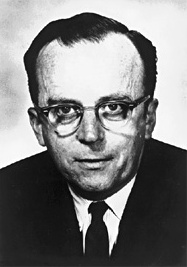
Joseph Carl Robnett Licklider, known simply as J. C. R. or "Lick", was an American psychologist and computer scientist who is considered to be among the most prominent figures in computer science development and general computing history.

Edward Fredkin was an American computer scientist, physicist and businessman who was an early pioneer of digital physics.
TELCOMP was a programming language developed at Bolt, Beranek and Newman (BBN) in about 1964 and in use until at least 1974. BBN offered TELCOMP as a paid service, with first revenue in October 1965. The service was sold to On-Line Systems, Inc. (OLS) in 1972. In the United Kingdom, TELCOMP was offered by Time Sharing, Ltd, a partnership between BBN and an entrepreneur named Richard Evans.

Intergalactic Computer Network or Galactic Network (IGCN) was a computer networking concept similar to today's Internet.

Wallace "Wally" Feurzeig was an American computer scientist who was co-inventor, with Seymour Papert and Cynthia Solomon, of the programming language Logo, and a well-known researcher in artificial intelligence (AI).
The Mercury was an early commercial computer from the mid-1950s built by Ferranti. It was the successor to the Ferranti Mark 1, adding a floating point unit for improved performance, and increased reliability by replacing the Williams tube memory with core memory and using more solid-state components. The computer had roughly 2000 vacuum tubes and 2000 germanium diodes. Nineteen Mercuries were sold before Ferranti moved on to newer designs.

The Interface Message Processor (IMP) was the packet switching node used to interconnect participant networks to the ARPANET from the late 1960s to 1989. It was the first generation of gateways, which are known today as routers. An IMP was a ruggedized Honeywell DDP-516 minicomputer with special-purpose interfaces and software. In later years the IMPs were made from the non-ruggedized Honeywell 316 which could handle two-thirds of the communication traffic at approximately one-half the cost. An IMP requires the connection to a host computer via a special bit-serial interface, defined in BBN Report 1822. The IMP software and the ARPA network communications protocol running on the IMPs was discussed in RFC 1, the first of a series of standardization documents published by what later became the Internet Engineering Task Force (IETF).
BBN LISP was a dialect of the Lisp programming language by Bolt, Beranek and Newman Inc. in Cambridge, Massachusetts. It was based on L. Peter Deutsch's implementation of Lisp for the PDP-1, which was developed from 1960 to 1964. Over time the language was expanded until it became its own separate dialect in 1966.
Daniel L. Murphy is an American computer scientist notable for his involvement in the development of TECO, the operating systems TENEX and TOPS-20, and email.
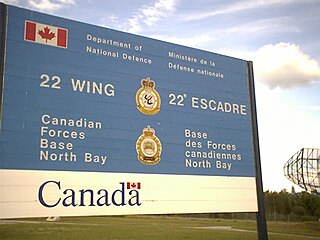
The AN/FSQ-32 SAGE Solid State Computer was a planned military computer of the United States Air Force. It was central for deployment to Super Combat Centers in nuclear bunkers and to some above-ground military installations. In 1958, Air Defense Command planned to acquire 13 Q-32 centrals for several Air Divisions/Sectors.
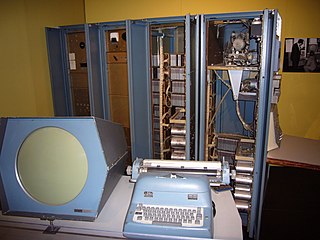
Colossal Typewriter by John McCarthy and Roland Silver was one of the earliest computer text editors. The program ran on the PDP-1 at Bolt, Beranek and Newman (BBN) by December 1960.
TENEX is an operating system developed in 1969 by BBN for the PDP-10, which later formed the basis for Digital Equipment Corporation's TOPS-20 operating system.














